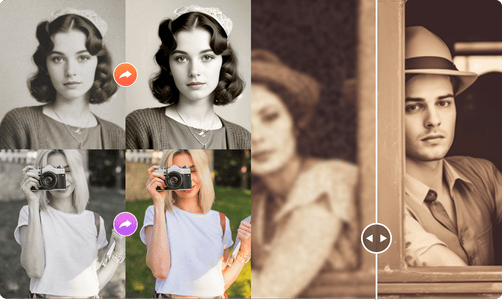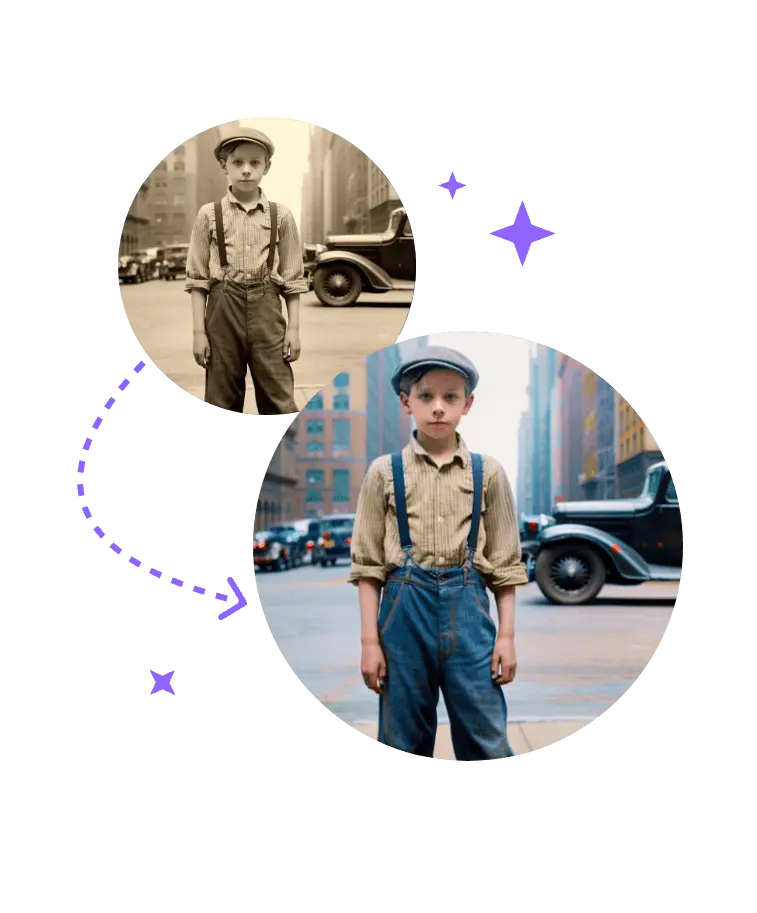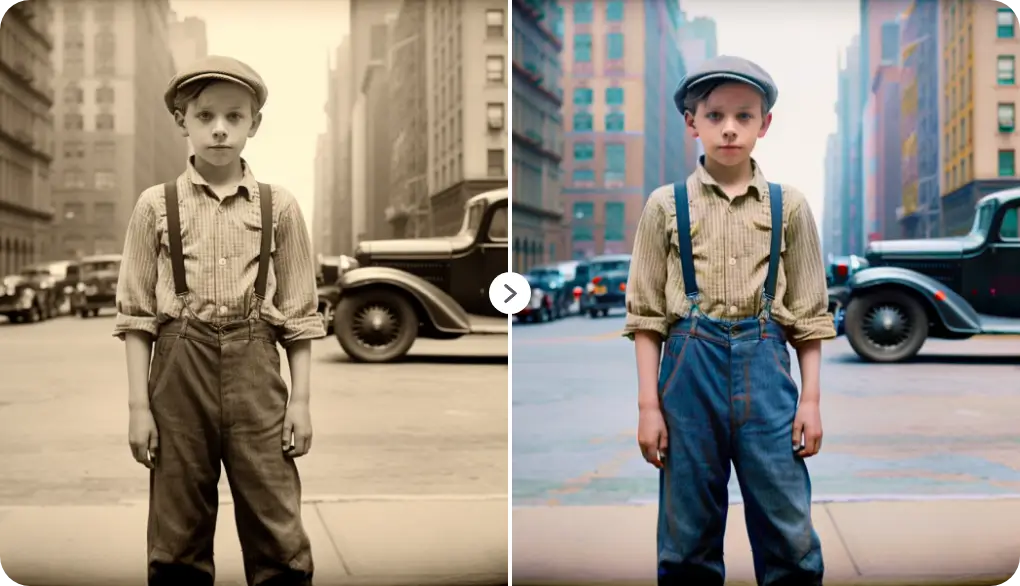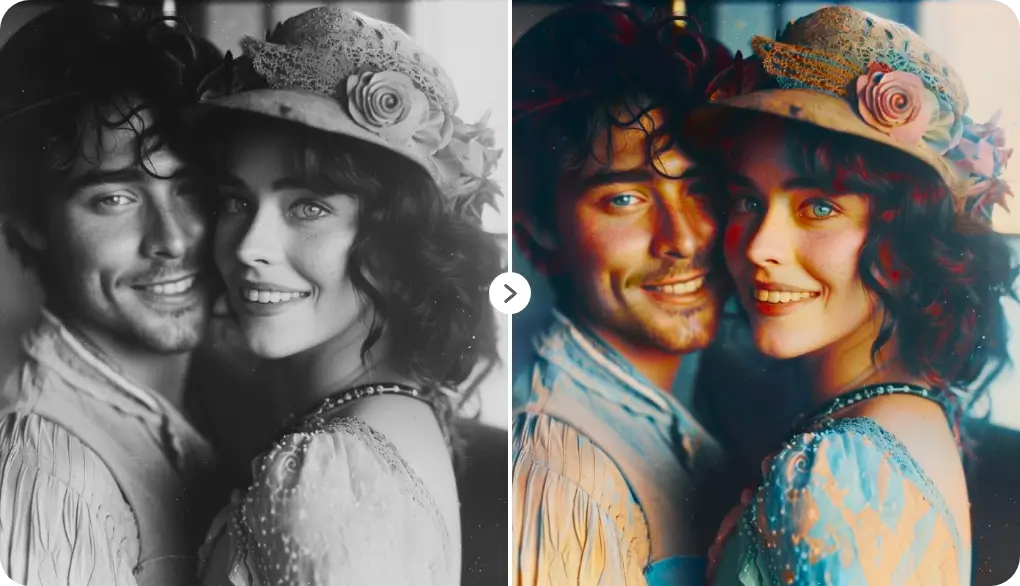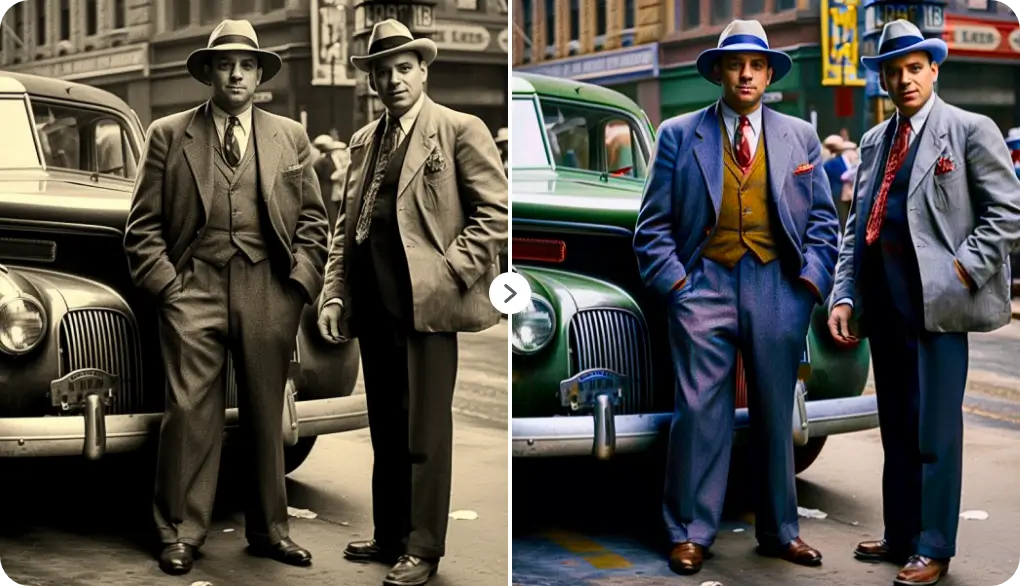AI old photo restoration – Restore old photos with AI online free
It is not the first time we see an old picture, and we suddenly feel engrossed to the extent that we feel like returning to the good old days. In fact, most times, when we remember the occurrence or the reason for the picture, we suddenly want to keep the picture with us for as long as possible. However, what is the use of keeping a photo that is almost worn off or spoiled? Nothing! It is better to be thrown away or discarded. On the other hand, do you know that you can restore and keep a worn-out image for yourself? Yes! We mean it. With photo restoration, you can get to keep that cherished photograph to yourself as long as possible. Without much story, in this guide, you will find out what photo restoration entails, how to go about it, and a lot more. What are you waiting for? Join us on the journey!
What Do You Understand By Photo Restoration?
Photo restoration is known as the digital process that is directed toward fixing and improving old photos. Just like it sounds, the main goal is to return these pictures to their original condition and sometimes to refine them. It might sound easy, but the cycle utilizes different procedures, including the use of artificial intelligence tools, to repair perceptible damages and work on the general nature of the photos.
We can also say “photo restoration” is a specialized process that involves restoring old, damaged, or blurred photos. The process involves a combination of art and science that uses advanced technology to fix and improve pictures, taking them back to their original state.
Understanding AI in Photo Restoration
Before we can understand the importance of AI in photo restoration, the concept behind it needs to be addressed. At first. What is AI? How does it work? AI refers to a computer system that can imitate human knowledge and gain information. Its importance to photo restoration lies in its capacity to consequently analyze and restore pictures. With its deep learning algorithms, neural networks, and generative adversarial networks (GANs), AI is able to perform a deep image super restoration. Artificial intelligence models are prepared using immense amounts of information to perceive designs and repair old photos with amazing accuracy.
The Process of Restoring Photos with AI
It is of the utmost importance to appropriately handle and arrange your old photos before the restoration process begins. In this stage, you want to assemble them in a safe and coordinated manner, safeguarding them from additional damage. Likewise, you want to ensure a well-scanned photo. Use high-resolution scanners to digitize the photos. Lastly, once digitized, you have to clean the digital scans to take out dust, scratches, and other imperfections that might affect the restoration process.
Challenges in Restoring Old Photos
Different photos come with different challenges, and we likewise need different approaches to tackle these challenges. Examples of these challenges are fading, which might be due to openness to daylight, staining from chemical reactions, actual damages like tears, scratches, or water stains, and even more damage in damp conditions.
Why Choose for AI-Powered Restoration?
There are various benefits associated with AI-powered restoration. Its speed and efficiency are what can’t be overlooked. Leveraging on its advanced algorithms, and machine learning features, AI technology can rapidly distinguish and fix various kinds of damage, right from scratches and tears to staining and blurring. In addition, AI restoration tools are often easy to use and affordable, making them ideal for people who need to restore their old photographs without spending much time or money on them.
AI Photo Restoration vs. Traditional Restoration Method
The difference between AI and traditional techniques has clear points. While the former offers an automated, proficient, and friendly UI, which will make the restoration process quicker and more open to a more extensive crowd, the latter offers an additional involved and customized touch, which can be very tedious and require a serious level of expertise. AI restoration is different from the traditional methods in different ways. Another common difference lies in their processing. As for AI, it automates the process, allowing anybody to restore photos in seconds, while traditional photo restoration requires a certain level of expertise and experience, and not everyone can restore photos through this means.
Choosing the Right AI Photo Restoration Tools
There are numerous AI restoration tools, and they can differ essentially depending on a few factors. Some of these tools include the algorithms, the machine learning models used, the damage in the first photograph, and the general quality of the picture. With a lot more of these factors, we can choose the right AI photo restoration tool, considering certain factors. Some of these factors include:
1. Restoration Accuracy
This is the first factor to consider when choosing an AI restoration tool for yourself. The AI tool must be able to restore your photos to their original look in terms of their color, details, and quality.
2. Usability
One more basic factor to also consider is the AI tool’s ease of use. You don’t want to choose a complicated AI tool that is hard to understand, but one that’s comprehensible even for people with practically zero technical ability.
3. Cost-Effectiveness
Another thing to consider is the cost-effectiveness of the AI tool. While some AI tools are free, some are premium, i.e., they are paid versions. These premium models offer better features, and if you want to get one, it should be one that offers a decent balance of cost and quality.
4. Data Security
Another factor to consider is security. You will be uploading your worn-out images onto the tool’s server, and you want it to be secure. Hence, the restoration tools should have a robust data protection system to secure your photographs’ security and privacy.
AI Tools for Restoring Old Photos
1. PicWish
PicWish is an across-the-board AI Photo restoration tool with regard to artificial intelligence tools for restoring old photographs. This tool is a strong AI tool with a range of features, such as a colorizer, an AI background generator, an image enhancer, and so on. Compared to the features, PicWish offers an extraordinary incentive for the money spent on far-reaching features.
2. Vance AI Photo Restorer
This is another fantastic artificial intelligence tool for restoring old photos. Due to its powerful algorithm, It is able to guarantee 100% restoration of photos while eliminating scratches and other harm from old photographs. Furthermore, this AI restoration tool ensures data security by erasing all uploaded photographs in 24 hours.
3. Pallete.fm
Pallete.fm is likewise an incredible AI tool for colorizing old photographs. Within a few seconds, Pallete.fm can restore damaged, blurred, or hazy photos back to their original quality. And with a paid plan, one can download the photographs at superior quality.
Using AVCLabs PhotoPro AI Tools for Photo Restoration
Over the years, various AI-based photo restoration software and tools have acquired prevalence because of their great abilities. An example of one that stands out is the AVCLabs PhotoPro AI, and we shall briefly take you through its description, features, and use.
This tool combines advanced artificial intelligence algorithms with an easy-to-use interface, which empowers experts and enthusiasts to restore old photographs with extraordinary outcomes.
Features of AVCLabs PhotoPro AI
The features include:
- Auto color correction.
- Enhance image resolution by 2x, 3x, 4x.
- Colorize old white and black photos.
- Upgrade picture sharpness and further improve clarity.
- Enhance face details from blurry pictures.
How to use AVCLabs PhotoPro AI for Photo Restoration
Step 1: Install AVCLabs PhotoPro AI on your PC and launch it.
Step 2: Import the Picture to the Program or simply drag and drop the old picture into the program.
Step 3: Select the AI model and Review the Picture Restore Effect
Two models are present here to assist you with fixing old photographs: “Enhance” and “Colorize.” If you wish to keep the color of an old photograph while working on the quality and fixing a few details,
Step 4: Simply pick the Enhance model in the upper right corner of the program. Then select Norm or HD on the right side of the program to enhance picture quality.
Tips: If necessary, you can turn on the Face Refinement option to pixelate old portrait photographs.
Step 5: After you have been done selecting, simply click “Apply”. Then, at that point, you can drag the vertical bar left and right to see the initial and final correlation.
Step 6: To color the old black-and-white photographs, simply select Colorize in the upper right corner of the program and click on “Apply.” Then, at that point, you can think about the difference between the black and white colors.
Stage 7: Exporting and Saving Restored Images
Assuming you are happy with the outcome, click the “Save” button to save the photograph to your preferred folder.
DIY Tips for Restoring Photos with AI
In the world of photo restoration, both novices and enthusiasts are not left out. Whether you’re a first-time user or you’re familiar with photo restoration apps, there are various DIY photograph restoration tips and software awaiting you. DIY photo restoration starts with readily available photo editing software that offers a variety of tools to restore and improve pictures. For example, Adobe Photoshop Elements has an easy-to-use interface, making it accessible to novices while offering fundamental restoration features. For those looking for other alternatives, like open-source, GIMP (GNU Image Manipulation Program) is a strong choice. With a functioning community and a range of plugins, GIMP takes into consideration creative freedom and restoration prospects.
Repairing Minor Damage in Old Photos
Minor damages are one of the easiest to heal. With the various editing tools, one can easily tend to minor damages and heal them. In fact, if dust and scratches are present in these photos, you can easily remove them with the clone stamp or healing brush tool; hence, new life is channeled into the images. On the other hand, if you are seeking to tackle tears and missing elements, you might find it a bit challenging, but it is not impossible. All you have to do is gently experiment with layers and blending modes, while carefully reconstructing the missing areas. And this can turn out to be a beneficial undertaking for the adventurous DIY restorer.
DIY Guide: Restore Your Old Photos Like a Professional
Instructions for Professional Photo Restoration
1. Scanning
Scan the photo at a high resolution (at least 600 dpi) to capture all the details. Keep in mind that, the final result depends on the scan.
2. Cleaning
After you have been scammed, carefully clean up the image with a software tool like Adobe Photoshop. Firstly, utilize the ‘spot healing brush’ tool to remove minor blemishes, dust, or scratches.
3. Repairing Damage
If any part is missing or torn, the ‘clone stamp’ tool is employable to replicate these areas of the photo and fill in the gaps. You need to be patient during this process, as it requires precision and creativity.
4. Color Correction
This is applicable If the image is discolored or faded. To fix this, simply adjust the color balance, saturation, and contrast to restore the original colors. This can take some time to master, so exercise patience and experiment.
5. Sharpening
All the above corrections are incomplete without sharpening. Hence, use the ‘sharpen’ tool to enhance the corrected details and make the image clearer. However, ensure it is done moderately. Overdoing it can make the photo look unnatural.
Keep in mind that photo restoration is an art. It’s not a day’s job. Time and practice are required to master it. Keep trying till you get it. Each photo offers a new opportunity to learn and improve.
Expert Tips for Best Results
1. Start Small
If you’re a novice when it comes to photo restoration, you want to start with less damaged photos. Along the way, you can learn to tackle more challenging projects.
Perseverance: Restoration is not something you get done in a second. Never rush the process. Better still, spend extra time getting it right rather than rush and get a bad result.
2. Backup Your Work
Always ensure to save the original scanned image. This is because you can always return to it if, along the way, something goes wrong. Hence, you don’t have to re-scan all over again.
3. Use Layers
Learn to apply layers for each step of your restoration process. With this, you can swiftly undo a step without affecting others.
4. Keep Learning
As we grow every day, so does the world of photo restoration. Check out for new tools, techniques, and best practices to keep your skills updated. Doing this will keep you on track to restore your precious old photos like a pro. Now keep it in the back of your mind that the goal of photo restoration isn’t only tied to repairing damage, but also to bringing the life, color, and memories that make each photo special back to life.
Repairing Tears and Missing Elements in Damaged Photos
We met a lot of trials on the road to our photo restoration. Some appear to be torn and damaged, with less hope of restoration. These photographs require both knowledge of science and art. And with the diverse digital tools and knowledge, the restoration process is made easier. Torn edges are easily mended, missing parts are carefully fixed, and faded colors are easily enhanced. Whether it is a missing face from a family portrait or a group photo that once defined a moment, the restoration tools are able to bring everything back to normal. But how? Through a combination of digital manipulation and expertise, one can endeavor to bridge the loopholes in the photographs, restoring the missing pieces with precision. With each stroke of the digital brush, which is like an act of visual archaeology, one can uncover the hidden layers of the past, gradually returning a lost essence.
Restore Damaged Photos
It’s not unusual to keep damaged photographs, because they’re meant to bring back old memories and are to be used as often as they might follow us to certain places in wallets and purses. If not all the time, handling them occasionally can also cause damage over time, and at the same time, the fragility of printing paper increases. Fortunately, with the right AI restoration tool, removing scratches, creases, and cracks caused by a life well lived is easy. One can even remove the dust, hair, and other particles that can stain the digitization process of old photos with these AI restoration tools.
In all the restoration challenges recorded, the restoration of black and white photos appears to be unique and captivating while brimming with emotion, and a careful approach is demanded. To restore black and white photos, one will need to unlock the secrets held within the shades of gray, where nuances and contrasts become the
canvas for visual storytelling. Careful navigation of the intricate tones is likewise essential, as this helps to breathe life into the images without the vibrant palette that colors offer.
Whoever is seeking a bridge between the past and present, opting for the black-and-white photo restoration might be the right step to take, as it offers a captivating window into history. With the right skill, these images transcend time, and the boundaries of eras, while also capturing the essence of the human experience.
Useful Tips for Preserving Photos
It is unlikely that you want your old photos to go bad. So, we will share with you tips on preserving your photos for as long as possible.
1. Regular Organization:
Organization is crucial to preserving photos. Here, you have to sort them into folders or albums according to the events, dates, or themes. Doing this will help you find your pictures easily, while also preventing scattered pictures.
2. Backup on Multiple Platforms
Backups for your photos are crucial. In case you lose them, you can easily recover them, and an example of this process is storing them on cloud-based services and external hard drives. With this, your photos are safe and secure.
3. Avoid Direct Sunlight
Sunlight or intense artificial light causes fading and discoloration to the picture. Hence, you want to store your pictures in cool, dry places that are free from sunlight rays.
4. Use Archival-Quality Materials
Archival-quality materials like paper, ink, and framing materials are designed to resist degradation over time. Hence, using them will help preserve your photos.
5. Handle with Clean Hands
Dirty Hands, especially those covered with oils, can transfer dirt to your photos, and this will easily damage your photos. Hence, ensure to use a clean hand to handle your photos from time to time.
The Importance of Keeping Our History Alive
The Importance of restoring and preserving photos cannot be overemphasized. With the main importance of preserving these photos being for the future generation, it can likewise serve as a means of interfacing us with people who preceded us, illuminating our present, and leaving a heritage for people in the future. Restoring old photos is by far more important than saving our images from decay. With it, we likewise keep our heritage in check, while celebrating our stories, and honoring the lives we lived. Deeply, photo restoration can also be described as a labor of love, proof of the enduring power of memory, and a contribution to the imprint of our shared human experience.
Conclusion: The Art of Bringing Memories to Life
Old photo preservation has been revolutionized with AI-based photo restoration, thereby allowing people to relive moments from the past vividly. In this guide, the benefits of using AI to restore old photos have been thoroughly discussed in terms of efficiency, accuracy, and an array of advanced techniques for enhancing photos. Likewise, we have also seen that, with the use of these AI tools and techniques, we will not only breathe new life into our old photos but also save them for future generations. So what is stopping you from embracing this technology and unlocking its potential to preserve and cherish your most reserved memories? Get smart and use it now! For more related, informative articles like this, stay tuned to our website.
